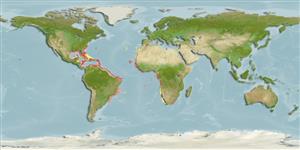Environment: milieu / climate zone / depth range / distribution range
Ökologie
seewasser bathydemersal; tiefenbereich 200 - 600 m (Ref. 4329), usually 300 - 500 m (Ref. 7321). Deep-water; 37°N - 35°S
Western Atlantic: New Jersey, USA (Ref. 31632) and the northern Gulf of Mexico to northeastern South America (Ref. 9626). Eastern Atlantic: Gulf of Guinea to Agulhas Bank.
Size / Gewicht / Alter
Maturity: Lm ? range ? - ? cm
Max length : 23.5 cm TL Männchen/unbestimmt; (Ref. 115012); max. veröff. Gewicht: 172.30 g (Ref. 115012)
Rückenflossenstacheln (insgesamt): 7; Rückenflossenweichstrahlen (insgesamt): 10; Afterflossenstacheln 2; Afterflossenweichstrahlen: 9. Membranous edge at the upper border of the gill cover is absent or poorly developed. No opercular spines. Caudal peduncle is short, body is deep (Ref. 31632). Specimens less than 8 cm SL with a dark band on peduncle at caudal base and a thin black ring on central part of peduncle (disappears in specimens greater than 11 cm SL) (Ref. 4329).
A mesobenthic-pelagic species living mainly above the bottom (Ref. 31632). Found on the continental slope (Ref. 7321).
Life cycle and mating behavior
Geschlechtsreife | Fortpflanzung | Ablaichen | Eier | Fecundity | Larven
Gon, O., 1986. Apogonidae. p. 546-561. In M.M. Smith and P.C. Heemstra (eds.) Smiths' sea fishes. Springer-Verlag, Berlin. (Ref. 4329)
IUCN Rote Liste Status (Ref. 130435)
Bedrohung für Menschen
Harmless
Nutzung durch Menschen
Fischereien: kommerzielles potential
Mehr Information
NamenSynonymeMetabolismusRäuberÖkotoxikologieFortpflanzungGeschlechtsreifeAblaichenSpawning aggregationFecundityEierEientwicklung
ReferenzenAquakulturAquakultur ProfilZuchtlinienGenetikElectrophoresesVererbbarkeitKrankheitenVerarbeitungNutrientsMass conversion
PartnerBilderStamps, Coins Misc.LauteCiguateraGeschwindigkeitSchwimmstilKiemenoberflächeOtolithsGehirngrößeSehfähigkeit
Tools
Zusatzinformationen
Download XML
Internet Quellen
Estimates based on models
Preferred temperature (Ref.
123201): 8.3 - 16.7, mean 11.5 °C (based on 122 cells).
Phylogenetic diversity index (Ref.
82804): PD
50 = 0.5000 [Uniqueness, from 0.5 = low to 2.0 = high].
Bayesian length-weight: a=0.01000 (0.00564 - 0.01774), b=3.09 (2.93 - 3.25), in cm total length, based on LWR estimates for this species & (Sub)family-body (Ref.
93245).
Trophic level (Ref.
69278): 3.5 ±0.5 se; based on size and trophs of closest relatives
Widerstandsfähigkeit (Ref.
120179): mittel, Verdopplung der Population dauert 1,4 - 4,4 Jahre. (Preliminary K or Fecundity.).
Fishing Vulnerability (Ref.
59153): Low vulnerability (14 of 100).
